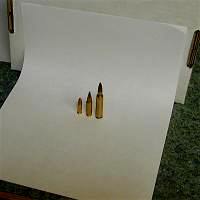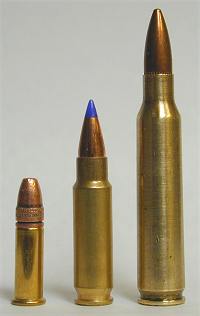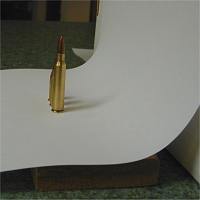This section contains brief discussions of various
ballistics and shooting related topics as requested by correspondents. If you have a
question you have been trying to find an answer to (keep 'em ballistics and shooting
related--see your minister for the mysteries of life) email me by clicking
here and I'll do my best to find the
answer for you and if it is of general interest, publish it here. If you can contribute
additional input to one of the answers I'd would appreciate hearing from you too.
Check back frequently as new topics are always being added.
On this page:
What brand of magazines do you recommend
for autopistols?
Is there an easy way to photograph
cartridges?
What affect does a cannelure have on the ballistic coefficient
of a bullet?
How do you determine the overall length to use for hollow
point autopistol ammunition if you don't have factory data?
Is there any way to give brass different colors?
How fast is the speed of sound (Mach)?
All the advertisements and gun
writers claim that the "short magnums" like the .300 WSM give the same
ballistics but have less recoil that the "standard" magnums like the
.300 Win Mag. Is this true.
Q. What brand of magazines
do you recommend for autopistols?
A. That's another one of those
questions that blood is frequently spilled over. There are many excellent
brands out there and everyone has their favorite brand. However, you pretty much get what you pay for. I personally
like the Tripp "Cobra Mags" for the 1911, but Wilson, ShootingStar,
and Metalform mags are also liked by many people, and Megar makes the
original equipment magazines for many manufacturers.
The important thing is to test them in YOUR pistol before
relying on them as due to tolerance stacking some brands may work better in your
pistol than others.
A couple of tips.
Whenever I buy magazines I always load them to full
capacity and let them sit for a week or two to let the springs take whatever set
they might get and then unload and inspect each magazine for digs, dents, and
sharp edges that may have sneaked past quality control. I then fire 50 rounds out of each magazine before relying on
them.
Don't forget to clean your magazines on a regular basis and check
them for damage and cracks. If you use magazines with all-polymer
followers be sure to inspect the slide stop shelf for wear and burring on a
regular basis.
If a magazine does not function well one thing you can
do is to use them as training magazines. Distinctively mark it (with say,
a colored base pad) and use it to practice malfunction drills
With proper care magazines can last a long time as can their
springs. Back in 1982 I was given 3 1911 GI magazines loaded with ball
ammo dated 1918 that were found in some personal effects of a person who had
died. The magazines had obviously seen heavy use and had been left loaded
since the end of WW I. They functioned perfectly then (as did the ammo)
and they still function fine today.
Q. Is there an easy way to photograph
cartridges?
A. The method that I've used for
years is very simple and doesn't require any special lighting. All you
need is a camera (regular or digital) that will focus closely (down to 6"
or less), a tripod, a piece of wood about 3/4" thick and a sheet or two of
bright white paper (I use 24 pound "104 brightness" inkjet
paper). I use any convenient diffused overhead lighting such as found in
any room with overhead fluorescent lighting, or even outdoor on an overcast day,
to minimize shadows. If you are using a digital camera that has a
"white balance" function you can use it to ensure that the background
shows as white and is not colored by the lighting. Keep the vertical
backdrop fairly close to the subject (2 to 4 inches) or your background may
appear darker than you want.
The pictures below are probably self explanatory but the white
paper draped over a board gives a no-edge background that is raised up enough
that the camera on the tripod can point straight in. Don't try to hand
hold the camera! Use a tripod! I hold the paper to the board with a strip of
double-sided tape and prop the back up with some books or a small box
With digital pictures you can use a paint program to crop and
adjust your image to your liking. I find that giving the image one notch
of sharpness enhancement makes the picture a bit crisper looking. Speaking
of digital cameras, one doesn't need a high megapixel spec'd camera if you are
taking pictures for a web site. A 2 MP model will do just fine--the
important things are close focusing and adjustable white balance (which you can
omit if you are careful about your lighting. Just get in close and fill
the frame with your subject.
For superior results use an off-camera flash held above the
camera location and angled down towards the items and set your camera to use
"aperture priority" and a small f-stop say about f16, to get good
depth of field.
By the way, if you use a digital camera you owe it to yourself to check out
Ken Rockwell's site www.kenrockwell.com.
While primarily dedicated to users of Nikon and Canon digital SLRs it is chock
full of useful photographic knowledge.
Q. What affect does a cannelure
have on the ballistic coefficient of a bullet?
A. The effect is quite small
and varies with the shape and depth of the cannelure and seems to vary between
about 3 and 12 percent. The table below shows the difference between several
bullets that are identical except for a cannelure.
| Bullet |
BC
(no cannelure) |
BC
(with cannelure) |
| 140 gr .264 boattail |
.550 |
.520 |
| 162 gr .280 boattail |
.625 |
.570 |
| 168 gr .308 boattail |
.475 |
.447 |
What is the actual effect way out there. No very
much unless you are talking about 1000 yards. At 500 yards the difference
in drop amounts to less than 2" and at 1000 yards to about 10"
assuming everything else stays the same.
Q. How do you determine the overall
length to use for hollow point autopistol ammunition if you don't have factory
data?
A. The overall
length must be such that the cartridge will feed smoothly and still fit in the
magazine.
The method I have successfully used for .45 ACP
ammunition is as follows. The critical setup seems to be having the bullet
seated to the depth that the nose of the hollow point bullet falls within the
profile of a properly seated FMJ RN bullet. I have a special seating stem cut to match
the profile of the GI 230 gr FMJ RN bullet, set in a spare seating die. I
set the test seater up to properly register on a GI ball round and then use
that setting to seat the HP bullet in question and then measure the overall
length. So far feeding has been perfect for all the bullets tried.
The illustration below shows what is trying to be accomplished. You can
probably adapt this method to other calibers that come with FMJ ammunition.
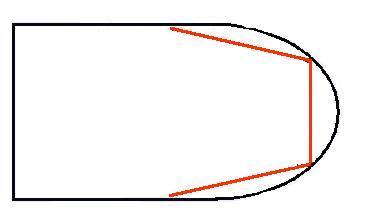
Q. Is there any way to give brass different colors?
A. The following information was
published on rec.guns on 17 March 1995, by Royce W. Beal.
It is reproduce here in full with permission.
Read this entire essay before attempting any one treatment. If
you choose to just "cut and paste" part of this, please make sure you
get the safety instructions and warnings after the recipes. Under no
circumstances do I consider myself liable for any accidents which occur while
using any of these chemicals. Also, I do not consider myself an expert in this
field and am still doing research for the FAQ. This will be a temporary
article. Because I am still experimenting, I cannot vouch for all of these
colors.
Concentrations and conditions DO matter. (Concentration is
more important than actual volume, so if you want to use less, make sure that
you use proportionately less of each ingredient.) If you want good results
follow the recipes closely. Above all it is important that the brass surfaces be
clean. This means an extra hour or so in the tumbler for the cases and then
touch them only sparingly.
I have tried to collate recipes which will require the
acquisition of the more common chemicals. I have also tried to steer clear of
the really hazardous arsenic and cyanide salts (which you probably can't get
anyway). If you feel that you've been cheated by this, please refer to the
references section of this report and find the books for yourself in any well
stocked library.
It is my understanding that these are all surface coatings and
should not damage or weaken the brass. Obviously you will want to do this
treatment with unprimed brass. DO NOT USE METAL UTENSILS (ok maybe stainless
steel), glass or plastic containers are the preference. If you are really
worried about what this is going to do to your brass, refer again to the
reference section below.
TIFFANY GREEN
| Copper
Sulfate |
8 ounces |
|
Ammonium Chloride |
4 ounces |
|
Sodium
Chloride |
4 ounces |
|
Zinc
Chloride |
1 ounce |
|
Acetic
Acid. |
2 ounces |
|
Water |
1 gallon |
VERDE
| Copper
Nitrate |
4 ounces |
|
Acetic
Acid |
1 quart |
|
Water |
1 gallon |
GREEN
| Iron ( ferric)
Nitrate * |
2
ounces |
|
Sodium Hyposulphite |
8 ounces |
|
Water |
1 gallon |
* Fe(III)(NO3)3)
Use at boiling temperature, brass can be
immersed or the solution may be "painted" on.
HARDWARE GREEN
| Iron (ferric)
Nitrate |
1 ounce |
|
Sodium Thiosulfate |
6 ounces |
|
Water |
1 gallon |
Use at 160F
RED
| Iron (ferric)
Nitrate |
6 ounces |
|
Sodium hyposulphite |
6
ounces |
|
Water |
1 gallon |
Using at 170F will speed up this reaction.
BLUE
| Sodium Hyposulphite |
8 ounces |
|
Lead
Acetate |
4 ounces |
|
Water |
1 gallon |
Use at boiling temperature.
or
| Lead
Acetate |
2 to 4 ounces |
|
Sodium Thiosulfate |
8 ounces |
|
Acetic
Acid |
4 ounces |
|
Water |
1 gallon |
Use at 180F. This color will change if not
lacquered [DO NOT LACQUER FIREARM CARTRIDGES] Take your chances with the color
change.
BLUE BLACK
| Copper
Carbonate |
1 pound |
|
Ammonium Hydroxide |
1
quart |
|
Water |
3 quarts |
Add the water after the carbonate and hydroxide
have been mixed. There must be excess Copper Carbonate. Use at 175F. This
color can be fixed (made more permanent) by quickly dipping in a 2.5% Sodium
Hydroxide solution.
BLACK
| Ammonium
Hydrosulfide |
2.25 ounces |
|
Potassium
sulfide |
1 ounce |
|
Water |
1 gallon |
Use at room temperature or COOLER for best
results.
BROWN
| Potassium
Chlorate |
5.5 ounces |
|
Nickel
Sulfate |
2.75 ounces |
|
Copper
Sulfate |
24 ounces |
|
Water |
1 gallon |
Use at boiling temperature.
SAFETY CONCERNS
- NEVER taste any of these chemicals.
- Keep very far out of the reach of children.
- Most Nitrates are good oxidizing agents and
should not be stored with anything flammable.
- Acetic Acid has a VERY strong pungent odor.
Use in well ventilated areas. This acid can be airborne in vapor form. If
you feel that you have breathed enough of it to feel uncomfortable, leave
the area and drink a carbonated soft drink. "Have a Coke" Do not
underestimate this chemical.
- Many of these chemicals may stain your skin
or clothing. Wear rubber gloves and protective clothing including glasses of
some sort.
- Steam can cause serious burns. Solutions of
salts can actually exceed the boiling point of water. The steam from these
solutions can be very dangerous. BE CAREFUL WITH STEAM AND BOILING
SOLUTIONS.
- Feel free to change concentrations for
experimentation purposes but do not change the ingredients in any one
recipe.
- Always be fully awake and alert around
chemicals.
CONVERSIONS AND
INTERPRETATIONS
Ounces are assumably troy ounces, even when dealing with
liquids or solutions. Do not use fluid ounces.
1 ounce = 31.103 grams = 480 grains
1 quart = 0.25 gallon = 946.4 mL
1 gallon = 3.785 L
REFERENCES
Meyer, Walter R., Plating and Finishing Guidebook,
ninth edition - 1940 pp.72-75 (cited)
Metal Finishing Guidebook twenty-eighth edition - 1960,
article by Hall, Nathaniel title Coloring of Metals pp. 477-479, (cited)
Krause, Hugo, Metal Coloring and Finishing (not cited)
Hiorns, A. H, Metal Coloring (not cited)
Field, S and Bonney, S.R., Chemical Coloring of Metals
(not cited)
Additional formulas can be found at http://www.sciencecompany.com/patinas/patinaformulas.htm
Q. How fast is the speed of sound (Mach)?
A: The speed of sound in air is variously given as
1070 to 1120 f/s and the exact answer depends on temperature and altitude.
In denser mediums the speed of sound increases as you can see from the data
below which give the speed of sound in various mediums.
| Medium |
Temp (Deg C) |
Velocity (f/s) |
| Air |
0 |
1,092 |
| Oxygen |
0 |
1,040 |
| Hydrogen |
0 |
4,164 |
| Carbonic Acid |
0 |
858 |
| River-water (Seine) |
15c |
4,741 |
| Solution of Common Salt |
18c |
5,132 |
| Common Alcohol |
20c |
4,218 |
| Solution Chloride of calcium |
23c |
6,493 |
| Medium |
Velocity at 20
Deg C
(f/s) |
Velocity at 100
Deg C
(f/s) |
Velocity at 200
Deg C
(f/s) |
| Lead |
4,030 |
3,951 |
- |
| Gold |
51,717 |
5,640 |
5,619 |
| Iron |
16,822 |
17,386 |
15,483 |
The following table lists the speed of sound in various woods.
| Wood |
Velocity Along
Fiber
(f/s) |
Velocity Across
Rings
(f/s) |
Velocity Along
Rings
(f/s) |
| Acacia |
15,467 |
4,840 |
4,436 |
| Fir |
15,218 |
4,382 |
2,572 |
| Beech |
10,965 |
6,028 |
4,643 |
| Oak |
12,662 |
5,036 |
4,229 |
| Pine |
10,900 |
4,611 |
2,605 |
| Elm |
14,639 |
4,916 |
3,728 |
| Sycamore |
15,314 |
4,567 |
4,142 |
| Ash |
16,677 |
5,297 |
2,987 |
| Elder |
15,306 |
4,491 |
3,423 |
| Aspen |
16,677 |
5,297 |
2,987 |
| Maple |
14,472 |
5,047 |
3,401 |
| Poplar |
14,052 |
4,600 |
3,444 |
As can be seen from the graphics below the change of Mach with altitude
is not uniform.
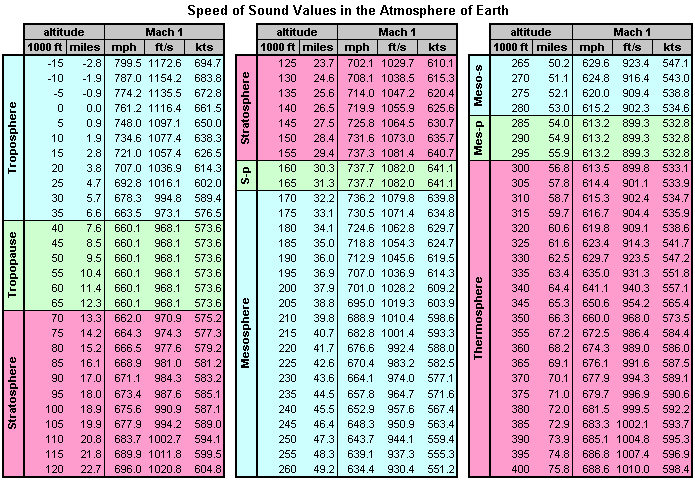
In the graphic below the atmosphere is broken down into
regions of decreasing temperature (blue), constant temperature (green), and
increasing temperature (red). This behavior is further illustrated below for the
Troposphere, Tropopause, Stratosphere, Stratopause, Mesosphere, Mesopause, and
lower Thermosphere. Above the Thermosphere is the Exosphere, which is well into
what is considered to be space.
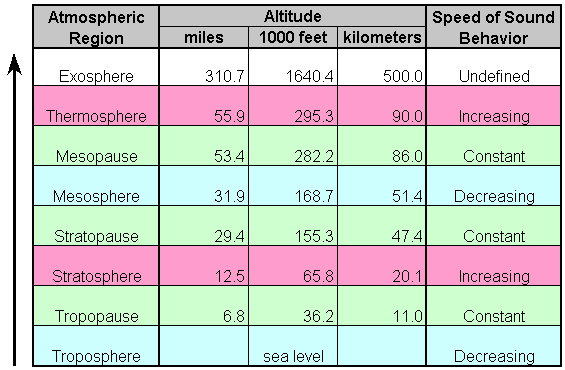
The graphic below gives an idea of temperature variation with
altitude.

Graphics courtesy of
http://www.aerospaceweb.org/question/atmosphere/q0112.shtml.
Q. All the advertisements and gun
writers claim that the "short magnums" like the .300 WSM give the same
ballistics but have less recoil that the "standard" magnums like the
.300 Win Mag. Is this true.
A. Well, er,
ah, ummm, ah...... Mainly advertising hype. The laws of physics state that
for every action there is an equal and opposite reaction. Let's look at the
facts. The stated ballistics (24") for a 180 gr bullet are
effectively 3000 f/s for both cartridges. Typical powder charges for the
WSM run about 65 - 70 grs and for the Win Mag about 80-85 gr.
Assuming an 8 pound rifle, a typical powder
charge, and running the numbers
for recoil (click here for more information) we
get
| |
Recoil Velocity
(f/s) |
Recoil Energy
(ft/lb) |
| .300 WSM 180gr @ 3000, 70 gr
powder |
14.6 |
26.6 |
| .300 Win Mag 180 gr @ 3000, 85
gr powder |
15.3 |
29.3 |
OK, the WSM computes as having lower recoil but by an almost
unnoticeable amount (3 ft/lbs is about the recoil of a 55 gr .223 in an 8 pound
rifle). The difference could easily be masked by stock
design. But even an inconsequential amount makes good add copy--the old
adage about preoccupation with inconsequential increments (PII) hold true here.
But there are some flies in that ointment.
First of all all of the .300 WSMs that I have seen chronographed seldom meet the
advertised velocity, running closer to 2925 than 3000 from a 24" barrel and
some are lower than that. (SAAMI specs require the velocity to be +/- 90
f/s from the stated velocity in a test barrel so there is a lot of jiggle room.)
Second, there are an awful lot of short barreled
.300 WSMs out there. I recently saw one with a 20(!!!) inch barrel.
The shorter barrels give about 30 f/s + less velocity per inch cut from
24" so a 20" .300 WSM is about like a Hornady .30-06 180 gr "Lite
Mag" loading or the old .300 H&H. Such progress we have.
Second most WSM handloads give noticeably less
maximum velocity than the equivalent "regular" magnums. Perusing
some loading manuals showed numerous maximum WSM loads giving 100 to 150 f/s
less velocity that equivalent "regular" magnum maximum loads so of
course recoil will be less under those circumstances. Reducing the
velocity to 2925 with a 180 gr bullet in the WSM drops the recoil energy and
velocity to about 25.5 ft/lb and 14 f/s respectively.
Does this all really matter? Not as far as
I am concerned. The modern American shooter has been conditioned to pretty much
fear recoil and the copy writers play this to the hilt. Some folks are
afraid of a .308 Win! Shooting from a bench (which is all some folks do)
with bad technique will hurt with even non-magnum calibers. Under field
conditions recoil simply is not a concern unless one is very slightly built
or frail. Unless you are shooting something
like a 45 caliber stopper or an ultra high velocity big bore like a .416 Rem mag,
worry about your marksmanship and not recoil. Having fired a number of
very powerful rifles over the years, the only ones whose recoil was really intolerable
were the .378 (only 61 ft/lb but very "sharp") and .460 Weatherbys (99 ft/lb), the .600 Nitro (107 ft/lb) and
.700 Nitro (115 ft/lb) Express rounds. (I will decline further shots with
either Express round.)
One thing not frequently mentioned about the short
magnums is the fact that they are very hard on barrels and have been known to erode
the throat out in under 500 rounds.
Please email comments to Fr. Frog by clicking
here.
| Back to Q&A Index | Ballistics Main
Page |
| Back to Fr. Frog's Home Page |
Disclaimer
As far as I know all the information presented above is
correct and I have attempted to ensure that it is. However, I am not responsible for any
errors, omissions, or damages resulting from the use or misuse of this information, nor
for you doing something stupid with it. (Don't you hate these disclaimers? So do I, but
there are people out there who refuse to be responsible for their own actions and who will
sue anybody to make a buck.)

Updated 2009-09-07
